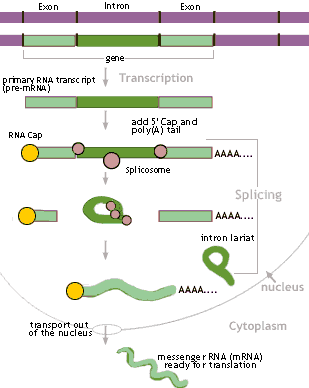 |
Processing
A newly made mRNA copy of a
gene (pre-mRNA), must undergo three major
modifications before it can leave the nucleus and be
translated into a protein:
1) Capping - a special nucleotide is attached at the
5' end of the mRNA. It is believed that this
modification is necessary for efficient initiation of
protein synthesis and serves as stabilisation.
2) Poly(A)-tail - a special enzyme attaches a chain
of 150-200 adenine nucleotides to the 3' end of the
pre-mRNA directly after transcription. This is
primarily believed to increase the stability and
therefore prolong the lifetime of an mRNA
molecule.
3) Splicing - The removal of noncoding sequences,
introns, from the pre-mRNA to create mRNA, containing
only the coding sequences for a protein. This process
is carried out by the splicosome. The splicosome is a
special complex made up by proteins and a catalytic
kind of small nuclear RNA molecules, the
snRNAs..
|

